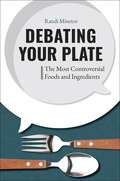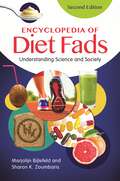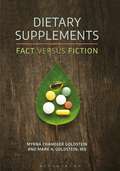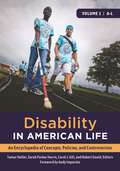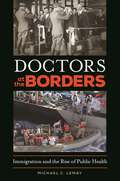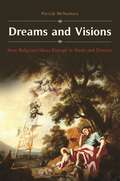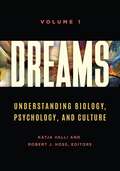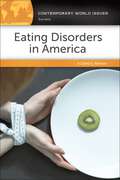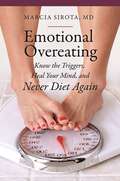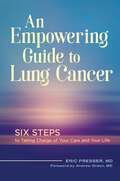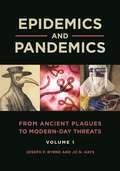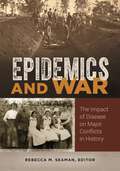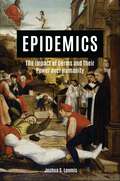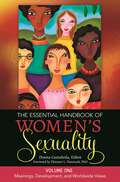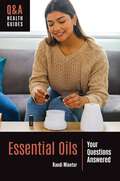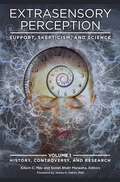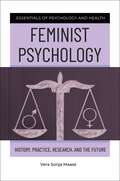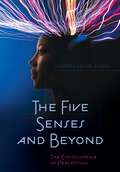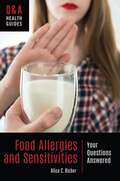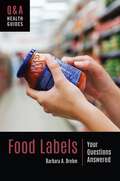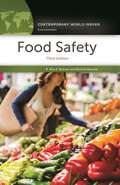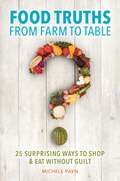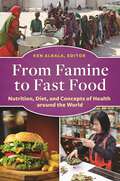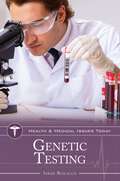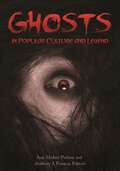- Table View
- List View
Debating Your Plate: The Most Controversial Foods and Ingredients
by Randi MinetorThis book examines the most controversial foods and ingredients, providing an objective, well-balanced look at the health benefits and risks of each. It equips readers with the information they need to make their own informed decisions about what they eat.Most people aspire to eat healthy, but what exactly does that mean? While some foods are universally acknowledged as beneficial, such as many vegetables, and others are widely condemned, such as added sugar, many foods have a more controversial reputation.Debating Your Plate: The Most Controversial Foods and Ingredients offers in-depth coverage of some of the most hotly debated items on grocery store shelves and dinner plates. Each entry provides thorough background and contextual information before examining the unique issues and controversies that surround that food or ingredient. By presenting both sides of the argument in clear, unbiased language, the book allows readers to form their own opinions about which items to include in their diet and which to avoid. On a larger scale, the book also examines why nutrition science is so prone to controversy and ambiguity, and it offers readers guidance on how to evaluate health claims for themselves.
Encyclopedia of Diet Fads: Understanding Science and Society
by Marjolijn Bijlefeld Sharon K. ZoumbarisThis updated encyclopedia examines the basics of nutrition and dieting, presenting the important people, concepts, and criticisms involved and examining the pros and cons of different plans.This A-to-Z reference describes many of the health fads and fashions of the past as well as current trends in weight loss to help people understand the principles of weight loss and the benefits of healthy choices. The authors help to identity effective means of losing weight and maintaining a healthy lifestyle, placing particular emphasis on weight-loss programs aimed at young people who struggle most with obesity, eating disorders, and body image. The book explores what works, what is potentially dangerous, and what scientists are discovering about nutrition, while also offering sustainable advice for keeping fit.The second edition of Encyclopedia of Diet Fads includes many updated, expanded, and completely new entries, as well as the latest information on diets and reviews many popular diet trends like the Atkins Diet, the Zone Diet, Weight Watchers, and Medifast. The book is organized by alphabetical entries regarding nutrition, exercise, and famous and infamous diet-promoters. Readers can learn more about an area that interests them through cross-referenced sections and a prolific list of additional resources. A selection of appendixes contains practical information such as how to evaluate diets and recipes.
Dietary Supplements: Fact versus Fiction
by Myrna Chandler Goldstein Mark A. MDThis accessibly written book examines the most commonly taken dietary supplements, exploring what they are and what they're purported to do, and summarizing key research findings regarding their potential health benefits and risks.Today, more than 50 percent of Americans take at least one type of dietary supplement regularly. But do these products actually work? How are they regulated? Are there any potential health risks? Dietary Supplements: Fact versus Fiction examines the most commonly used non-nutrient supplements (those that are neither vitamins nor minerals and not essential for human health). Using a standardized structure, each entry discusses a particular supplement's origins, purported benefits, potential risks, and common dosage. Summaries of key research studies are included to help readers make informed decisions about supplements' usefulness. Introductory materials give readers a foundational understanding of how supplements are regulated and labeled and offer practical information about how to read a Supplement Facts panel. For those interested in supplements for a particular health complaint (such as fatigue or pain), a topic finder has also been included.
Disability in American Life [2 volumes]: An Encyclopedia of Concepts, Policies, and Controversies [2 volumes]
by Tamar Heller, Sarah Parker Harris, Carol J. Gill, and Robert GouldDisability—as with other marginalized topics in social policy—is at risk for exclusion from social debate. This multivolume reference work provides an overview of challenges and opportunities for people with disabilities and their families at all stages of life.Once primarily thought of as a medical issue, disability is now more widely recognized as a critical issue of identity, personhood, and social justice. By discussing challenges confronting people with disabilities and their families and by collecting numerous accounts of disability experiences, this volume firmly situates disability within broader social movements, policy, and areas of marginalization, providing a critical examination into the lived experiences of people with disabilities and how disability can affect identity.A foundational introduction to disability for a wide audience—from those intimately connected with a person with a disability to those interested in the science behind disability—this collection covers all aspects of disability critical to understanding disability in the United States. Topics covered include characteristics of disability; disability concepts, models, and theories; important historical developments and milestones for people with disabilities; prominent individuals, organizations, and agencies; notable policies and services; and intersections of disability policy with other policy.
Doctors at the Borders: Immigration and the Rise of Public Health
by Michael C. LeMayA unique resource for the general public and students interested in immigration and public health, this book presents a comprehensive history of public health and draws 10 key lessons for current immigration and health policymakers.The period of 1820 to 1920 was one of mass migration to the United States from other nations of origin. This century-long period served to develop modern medicine with the acceptance of the germ theory of disease and the lessons learned from how immigration officials and doctors of the United States Marine Hospital Service (USMHS) confronted six major pandemic diseases: bubonic plague, cholera, influenza, smallpox, trachoma, and yellow fever. This book provides a narrative history that relates how immigration doctors of the USMHS developed devices and procedures that greatly influenced the development of public health. It illuminates the distinct links between immigration policy and public health policy and distinguishes ten key lessons learned nearly 100 years ago that are still relevant to coping with current public health policy issues.By re-examining the experiences of doctors at three U.S. immigration/quarantine stations—Angel Island, Ellis Island, and New Orleans—in the early 19th century through the early 20th century, Doctors at the Borders: Immigration and the Rise of Public Health analyzes the successes and failures of these medical practitioners' pioneering efforts to battle pandemic diseases and identifies how the hard-won knowledge from that relatively primitive period still informs how public health policy should be written today. Readers will understand how the USMHS doctors helped shape the very development of U.S. public health and modern scientific medicine, and see the need for international cooperation in the face of today's global threats of pandemic diseases.
Dreams and Visions: How Religious Ideas Emerge in Sleep and Dreams (Brain, Behavior, and Evolution)
by Patrick McNamara Ph.D.A standout resource on the emerging field of applying neuropsychology and the latest findings in sleep and dream research to religious experience, this book investigates the proven biological links between REM dreams and religious ideas, covering past and current schools of thought in both the science of dreams and the science of religion.Across time and around the world, billions of people with highly dissimilar backgrounds and cultures have felt spiritual or religious inspiration that shaped their lives and supplemented their mental strength—and in many cases, this inspiration came via a dream. The "how" and "why" of this common phenomenon is one that science has largely failed to explain. In this book, nationally recognized behavioral neuroscientist Patrick McNamara taps the latest science in sleep and dreams as well as neuropsychology to investigate one facet of the answer from the "inside out"—the human brain's role.The first study of its kind in an emerging field, Dreams and Visions: How Religious Ideas Emerge in Sleep and Dreams provides a comprehensive summary of past theory and examines the latest science on dreams, REM sleep, cognitive approaches to religion, and neuroscience approaches to religion. Readers will come away with an in-depth understanding of how and why god beliefs and spiritual convictions so often emerge in our dreams. Dedicated sections address special dream types like visitation dreams, nightmares, precognitive dreams, "big" dreams, lucid dreams, paralysis dreams, twin dreams, and more.
Dreams [2 volumes]: Understanding Biology, Psychology, and Culture [2 volumes]
by Katja Valli, Robert J. Hoss and Robert P. GongloffThis two-volume set examines dreams and dreaming from a variety of angles—biological, psychological, and sociocultural—in order to provide readers with a holistic introduction to this fascinating subject.Whether good or bad and whether we remember them or not, each night every one of us dreams. But what biological or psychological function do dreams serve? What do these vivid images and strange storylines mean? How have psychologists, religions, and society at large interpreted dreams, and how can a closer examination of our dreams provide useful insights?Dreams: Understanding Biology, Psychology, and Culture presents a holistic view of dreams and the dreaming experience that answers these and many other questions. Divided thematically, this two-volume book examines the complex and often misunderstood subject of dreaming through a variety of lenses. This collection is written by a large and diverse team of experts and edited by leading members of the International Association for the Study of Dreams (IASD) but remains an approachable and accessible introduction to this captivating topic for all readers.
Eating Disorders in America: A Reference Handbook (Contemporary World Issues)
by David E. NewtonAn indispensable resource for readers interested in eating disorders, this book summarizes their history in human civilization, assesses the current status of eating disorders in American society, and describes efforts for establishing effective prevention and treatment programs.Although eating disorders have existed for centuries, considerable controversy remains as to the basic cause or causes of these disorders and their genetic, biological, and/or psychological factors. Eating Disorders in America: A Reference Handbook investigates these disorders, priming readers on the causes, symptoms, controversies, and treatments available. The two opening chapters of the book provide general background and a historical review of the existence of eating disorders in society. The remaining chapters provide resources the reader can use for further research, such as an extensive annotated bibliography, a glossary, and a chronology. This book differs from others on the topic in that it provides both an expository section that provides information as well as a set of resources for further research. The book also contains a "perspectives" chapter in which writers describe and discuss their personal views on the subject of eating disorders. Together with the author's expertise, these views add to the value of this book as a resource for eating disorder research.
Emotional Overeating: Know the Triggers, Heal Your Mind, and Never Diet Again (The Praeger Series on Contemporary Health and Living)
by Marcia Sirota M.D.This compelling book examines what causes compulsive eating, and provides methods for dealing with the emotional and psychological issues at the root of the problem.Weight loss has been a struggle for countless people in our food-obsessed culture; even achieving a healthy relationship with food is difficult for many Americans. Why is this? Respected author Marcia Sirota examines this phenomenon, exploring the emotional and psychological factors involved with overeating and food addiction. Emotional Overeating: Know the Triggers, Heal Your Mind, and Never Diet Again starts with the root cause of obesity and ends with practical techniques to find freedom from the urge to overeat. The author provides an overview of the overeating and obesity problem, offers a critical look at the downfalls of dieting, and reveals the reasons why many of us use food to supplant a real emotional need. The book includes numerous exercises and specific tools for healing, as well as an avenue to effortless permanent weight loss.
An Empowering Guide to Lung Cancer: Six Steps to Taking Charge of Your Care and Your Life
by Eric Presser MDDispelling the commonly held belief that lung cancer is always self-inflicted, this book guides patients, their loved ones, and caregivers through diagnosis, acceptance, and treatment, and provides support and hope to the tens of thousands of people coping with this illness.Lung cancer is a serious illness—one that is considered among medicine's most dreaded diagnoses. Alone, it's responsible for 29 percent of cancer deaths in the United States and causes more deaths than breast, colon, ovarian, and prostate cancer combined! Additionally, lung cancer isn't typically discovered until it causes symptoms, at which point options are limited and the chances of a cure greatly reduced. But it doesn't have to be this way. In this book, Dr. Eric Presser provides an empowering, comprehensive guide to lung cancer for anyone seeking a deeper understanding of the treatments available, coping with the diagnosis, and dealing with the side effects associated with the disease on both patients and their loved ones. His book offers a complete resource for anyone touched by lung cancer, presenting the latest scientifically tested information to help reduce the rates of illness and infirmity and ultimately make lung cancer a thing of the past. The book first covers the basic information necessary to understand lung cancer, including lung anatomy. Dr. Presser then identifies the six steps that will with help people cope with lung cancer and take charge of their lives. The final section focuses on nutrition and lung cancer in addition to practical concerns such as health insurance, work and disability, and financial challenges.
Epidemics and Pandemics [2 volumes]: From Ancient Plagues to Modern-Day Threats [2 volumes]
by Joseph P. Byrne Jo N. HaysBeyond their impact on public health, epidemics shape and are shaped by political, economic, and social forces. This book examines these connections, exploring key topics in the study of disease outbreaks and delving deep into specific historical and contemporary examples.From the Black Death that ravaged Europe in the 14th century to the influenza pandemic following World War I and the novel strain of coronavirus that made "social distancing" the new normal, wide-scale disease outbreaks have played an important role throughout human history. In addition to the toll they take on human lives, epidemics have spurred medical innovations, toppled governments, crippled economies, and led to cultural revolutions.Epidemics and Pandemics: From Ancient Plagues to Modern-Day Threats provides readers with a holistic view of the terrifying—and fascinating—topic of epidemics and pandemics. In Volume 1, readers will discover what an epidemic is, how it emerges and spreads, what diseases are most likely to become epidemics, and how disease outbreaks are tracked, prevented, and combatted. They will learn about the impacts of such modern factors as global air travel and antibiotic resistance, as well as the roles played by public health agencies and the media. Volume 2 offers detailed case studies that explore the course and lasting significance of individual epidemics and pandemics throughout history.
Epidemics and War: The Impact of Disease on Major Conflicts in History
by Rebecca M. SeamanThrough its coverage of 19 epidemics associated with a broad range of wars, and blending medical knowledge, demographics, geographic, and medical information with historical and military insights, this book reveals the complex relationship between epidemics and wars throughout history.How did small pox have a tremendous effect on two distinct periods of war—one in which the disease devastated entire native armies and leadership, and the other in which technological advancements and the application of medical knowledge concerning the disease preserved an army and as a result changed the course of events? Epidemics and War: The Impact of Disease on Major Conflicts in History examines fascinating historical questions like this and dozens more, exploring a plethora of communicable diseases—viral, fungal, and/or bacterial in nature—that spread and impacted wars or were spread by some aspect of mass human conflict.Written by historians, medical doctors, and people with military backgrounds, the book presents a variety of viewpoints and research approaches. Each chapter examines an epidemic in relation to a period of war, demonstrating how the two impacted each other and affected the populations involved directly and indirectly. Starting with three still unknown/unidentified epidemics (ranging from Classical Athens to the Battle of Bosworth in England), the book's chapters explore a plethora of diseases that spread through wars or significantly impacted wars. The book also examines how long-ended wars can play a role in the spread of epidemics a generation later, as seen in the 21st-century mumps epidemic in Bosnia, 15 to 20 years after the Bosnian conflicts of the 1990s.
Epidemics: The Impact of Germs and Their Power over Humanity
by Joshua S. LoomisThis book comprehensively reviews the 10 most influential epidemics in history, going beyond morbid accounts of symptoms and statistics to tell the often forgotten stories of what made these epidemics so calamitous.Unlike other books on epidemics, which either focus on the science behind how microbes cause disease or tell first-person accounts of one particular disease, Epidemics: The Impact of Germs and Their Power over Humanity takes a holistic approach to explaining how these diseases have shaped who we are as a society. Each of the worst epidemic diseases is discussed from the perspective of how it has been a causative agent of change with respect to our history, religious traditions, social interactions, and technology. In looking at world history through the lens of epidemic diseases, readers will come to appreciate how much we owe to the oldest and smallest parasites. Adults and students interested in science and history—and especially anyone who appreciates a good story and has a healthy curiosity for the lesser-known facts of life—will find this book of interest. Health-care workers will also benefit greatly from this text, as will college students majoring in biology or a pre-health field.
The Essential Handbook of Women's Sexuality [2 volumes]: [2 volumes] (Women's Psychology)
by Donna CastañedaThis cutting-edge two-volume set with contributions by distinguished and internationally recognized scholars provides a comprehensive picture of contemporary issues in the field of women's sexuality, emphasizing women's diversity and international perspectives.The multifaceted field of women's sexuality has expanded as a field of inquiry over the last 25 years to encompass a wide range of new perspectives, theories, topics, findings, and controversies. The chapters in this work review and question the utility of standard sexuality frameworks, addressing purely biological models, heteronormative definitions of sexuality, and others; and provide new insights and approaches to understanding women's sexuality. The intersectional and contextual nature of women's sexuality and how it is inextricably connected to women's relational, social, economic, and cultural contexts is highlighted. The Essential Handbook of Women's Sexuality includes in-depth coverage of a wide range of women's sexuality topics, including sexual desire and satisfaction; sexuality in relationships; development across the lifespan; sexuality concerns in diverse countries; pornography; lesbian, bisexual, and transgender women; women from diverse backgrounds; health and sexuality; reconceptualizations of women's sexual problems; trauma, rape, and intimate partner violence; and mental health and therapy. These volumes can serve as a resource for students, researchers, and anyone seeking a greater understanding of women's sexuality.
Essential Oils: Your Questions Answered (Q&A Health Guides)
by Randi MinetorThis book provides easy-to-understand, scientifically backed answers to readers' questions about essential oils, helping them make informed decisions about which products to use and how and setting realistic expectations about what essential oils can and cannot do to improve well-being.Many people use essential oils regularly yet know very little about them. What exactly makes them "essential"? Can they really be used to treat ailments like infections, fevers, and sore throats? Is it safe to ingest them or use them around children and pets? How can you tell if a company selling essential oils is offering a low-quality product or engaging in shady business practices? This book answers these and many more questions about these popular yet often poorly understood products.Books in Greenwood's Q&A Health Guides series follow a reader-friendly question-and-answer format that anticipates readers' needs and concerns. Prevalent myths and misconceptions are identified and dispelled, and a collection of case studies illustrate key concepts and issues through relatable stories and insightful recommendations. Each book also includes a section on health literacy, equipping teens and young adults with practical tools and strategies for finding, evaluating, and using credible sources of health information both on and off the internet—important skills that contribute to a lifetime of healthy decision-making.
Extrasensory Perception [2 volumes]: Support, Skepticism, and Science [2 volumes]
by Edwin C. May and Sonali Bhatt MarwahaScholars from around the world collaborate to explain the history of parapsychology, the study of extrasensory perception (ESP), and the arguments of skeptics and supporters in this fascinating collection.This two-volume set introduces ESP—also known as anomalous cognition—and psychokinesis, addressing the history, research, philosophy, and scientific theories surrounding the phenomena. With contributions from leading research scientists from within the field of parapsychology and other areas of study, this reference addresses the fundamental questions that the evidence of ESP evokes; examines parapsychology research from all over the world; and explores the controversies, skepticism, and contemporary criticism disparaging the field.Written for a multidisciplinary audience ranging from physicists to psychologists to lay persons, the volumes present the scientific validity of the field. Volume 1 addresses the historical, philosophical, skeptical, and research viewpoints; volume 2 lays out the current theories on ESP. Chapters reveal how strict scientific protocols and state-of-the-art technologies enable scientists—at sites such as Harvard and Cornell universities to their international counterparts in Amsterdam, Austria, and Asia—to pinpoint and investigate ESP abilities. Appendices include a glossary of key terms in parapsychology, ESP research protocol, ESP research organizations, skeptic associations, and recommended reading.
Feminist Psychology: History, Practice, Research, and the Future (Essentials of Psychology and Health)
by Vera Sonja MaassDetailing the field of feminist psychology since its origins, this book assesses its early figures, theory, and research as well as current and emerging theory and research and its associations with general feminist beliefs.Feminist psychology developed as a reaction to historical psychological thought initiated by men who controlled the theory and research of the field. By holding all of society to "norms" based in male behavior, this so-called "masculine psychology" effectively assigned women lower societal status than men and had disturbing effects on women's health and self-esteem.Feminist Psychology focuses on gender differences, social structure, and the values and principles of women's rights within the world's individual, social, and political spheres. Contrary to popular notion, feminist psychology does not involve man-hating, but instead focuses on loving the concept that women have equal potential to set and achieve goals and to contribute to society. In this volume, psychologist Vera Maass explains the history, theory, research, and current state of this growing field, which is becoming increasingly popular as colleges offer majors or concentrations in feminist psychology, and argues that women are both different from and equal to men.
The Five Senses and Beyond: The Encyclopedia of Perception
by Jennifer L. Hellier, EditorHow do our human senses work and help us interact with our surroundings, and what happens when these senses malfunction or are impaired? This book provides in-depth information that answers these questions and more.The Five Senses and Beyond: The Encyclopedia of Perception supplies students and general readers with accurate, up-to-date information about the human senses. It explains the "big five" senses in detail as well as lesser-known but important senses—perceptions such as balance, kinesthesia, temperature, and pain. After a helpful introduction, this reference work provides A-to-Z, cross-referenced entries on hundreds of topics in the realm of human perception that allow students to find and digest information quickly and draw connections between related topics. Through the use of activity sidebars, readers will also be able to explore the workings of the senses firsthand, lending an element of interactivity to this accessible encyclopedia. A convenient end-of-volume glossary provides definitions of unfamiliar terms.
Food Allergies and Sensitivities: Your Questions Answered (Q&A Health Guides)
by Alice C. RicherAn easy-to-understand introduction to food allergies, sensitivities, and intolerances—unique but related conditions affecting many children and adults. The information, guidance, and resources offered make this a valuable tool for anyone struggling with negative reactions to certain foods.While many people think that any negative reaction after eating a food indicates an allergy, that's not the case. True food allergies, along with more common food intolerances and sensitivities, can produce a wide range of symptoms, from unpleasant bloating to life-threatening anaphylactic shock. What causes these conditions, and how can they be treated or managed? Why are certain foods, like peanuts and milk, more problematic than others? Why are food allergies on the rise, and is this only a problem in the industrialized world? Food Allergies and Sensitivities: Your Questions Answered, a part of Greenwood's Q&A Health Guides series, answers these and other questions related to this fascinating topic. Each book in this series follows a reader-friendly question-and-answer format that anticipates readers' needs and concerns. Prevalent myths and misconceptions are identified and dispelled, and a collection of case studies illustrates key concepts and issues through relatable stories and insightful recommendations. The book also includes a section on health literacy, equipping teens and young adults with practical tools and strategies for finding, evaluating, and using credible sources of health information both on and off the internet—important skills that contribute to a lifetime of healthy decision-making.
Food Labels: Your Questions Answered (Q&A Health Guides)
by Barbara A. BrehmThis book provides an approachable introduction to food labels. While aimed primarily at teens and young adults, it is a valuable tool for anyone who wants to better understand what food labels are really saying and make healthy food choices.How accurate is the Nutrition Facts Panel, and who decides what information goes on it? Why don't all foods have nutrition or ingredient information? How can you tell if a product is organic, non-GMO, or ethically produced? Are words such as "all-natural" and "light" on packaging meaningful or just clever marketing? Food Labels: Your Questions Answered, a part of Greenwood's Q&A Health Guides series, provides clear, concise answers to these and many other questions readers may have about the labels and health claims found on food packaging.Each book in this series follows a reader-friendly question-and-answer format that anticipates readers' needs and concerns. Prevalent myths and misconceptions are identified and dispelled, and a collection of case studies illustrates key concepts and issues through relatable stories and insightful recommendations. The book also includes a section on health literacy, equipping teens and young adults with practical tools and strategies for finding, evaluating, and using credible sources of health information both on and off the internet—important skills that contribute to a lifetime of healthy decision-making.
Food Safety: A Reference Handbook (Contemporary World Issues)
by Nina E. Redman Michele MorronePresenting compelling and current information about some of the most important food safety issues, this book is an invaluable reference for anyone interested in avoiding foodborne disease or understanding how food safety standards could be improved.Food safety affects everyone. For citizens who live in industrialized nations, it is easy to assume that our foods are always rigorously inspected and assessed for safety. While food safety standards and regulations are in place to protect the consumer public, food safety problems do exist: according to the Centers for Disease Control and Prevention, each year, 48 million Americans are sickened by food,128,000 people are sick enough that they are hospitalized as a result, and 3,000 people die from foodborne pathogens.This third edition of Food Safety: A Reference Handbook examines the history of food safety and describes in detail key events and trends that have created the food safety issues of today. It explores the many controversies concerning food consumption, including contaminants in food, GMOs, factory farm-produced meat, and standards regarding the labeling of food products as well as the ways that these issues have been handled by authorities. Readers will find this book's overview of food safety topics informative and highly accessible. Additionally, the perspectives chapter provides varying viewpoints from food safety professionals and researchers on key issues.
Food Truths from Farm to Table: 25 Surprising Ways to Shop & Eat without Guilt
by Michele PaynDon't believe everything you're told about food—most of it is highly misleading or completely untrue. Written by a farm and food advocate, this book identifies marketing half-truths and guides you through the aisles of the grocery store to simplify smart food shopping and restore your freedom to enjoy food.What is the only "food" on your dinner table that does not contain hormones? How can animals raised for food also be treated with respect? Is it true that a typical serving of broccoli has more estrogen than a serving of steak? Why is more than 40 percent of food wasted in the United States? Food Truths from Farm to Table: 25 Surprising Ways to Shop & Eat without Guilt answers all of these questions and many more, bringing an unheard voice into the highly emotional food debate. Authored by Michele Payn, a leading farm and food advocate with an in-depth understanding of both sides of the plate, this intriguing book helps readers understand how food is really produced, answers food critics, and points out how food marketing and labels are often half-truths or even "less-than-half truths." These 25 food truths enable an understanding of how food is grown, providing a transparent window into today's farming and ranching practices that empowers you to make informed personal choices and determine what is right for your family. Each chapter presents a farm or ranch story, answers questions around a major issue, provides science-based information, and includes a sidebar section of food truths and myths.Readers will gain insights from a food expert who offers a viewpoint that stands in stark contrast to the typical sensationalist and often negative perspective on fashionable food—accurate information that will help you to better trust the intentions and processes in farming and ranching. The revelations in this book will simplify food shopping, reduce guilt about being a consumer, and give you the freedom to enjoy your food again.
From Famine to Fast Food: Nutrition, Diet, and Concepts of Health around the World
by Ken Albala Julia Abramson M. Shahrim Al-Karim E. N. Anderson Laura P. Appell-Warren Heather Arndt-Anderson Michael Ashkenazi Babette Audant Gabriela Villagran Backman Carolyn Bánfalvi Peter Barrett Cynthia D. Bertelsen Megan K. Blake Andrea Broomfield Cynthia Clampitt Neil L. Coletta Paul Crask Christine Crawford-Oppenheimer Anita Verna Liza Debevec Jonathan Deutsch Deborah Duchon Nathalie Dupree Pamela Elder Rachel Finn Richard Foss Nancy G. Freeman Ramin Ganeshram Hanna Garth Mary Gee Che Ann Abdul Ghani Maja Godina-Golija Annie Goldberg Darra Goldstein Keiko Goto Carla Guerrón Montero Mary Gunderson Liora Gvion Cherie Y. Hamilton Jessica B. Harris Melanie Haupt Ursula Heinzelmann Jennifer Hostetter Kelila Jaffe Zilkia Janer Brelyn Johnson Kate Johnston Desiree Koh Bruce Kraig R. J. Krajewski Erin Laverty Robert A. Leonard Jane Levi Yrsa Lindqvist William G. Lockwood Yvonne R. Lockwood Janet Long-Solís Kristina Lupp Máirtín Mac Con Iomaire Glenn R. Mack Andrea Macrae Giorgos Maltezakis Bertie Mandelblatt Marty Martindale Laura Mason Anton Masterovoy Anne Engammare Mcbride Michael R. Mcdonald Naomi M. Mcpherson Katrina Meynink Barbara J. Michael Diana Mincyte Rebecca Moore Nawal Nasrallah Henry Notaker Kelly O’ Leary Fabio Parasecoli Susan Ji-Young Park Rosemary Parkinson Charles Perry Irina Petrosian Suzanne Piscopo Theresa Preston-Werner Meg Ragland Carol Selva Rajah Birgit Ricquier Amy Riolo Owen Roberts Fiona Ross Signe Rousseau Kathleen Ryan Helen Saberi Cari Sánchez Peter Scholliers Colleen Taylor Roger Serunyigo Dorette Snover Celia Sorhaindo Lyra Spang Lois Stanford Aliza Stark Maria "Ging" Gutierrez Steinberg Anita Stewart Emily Stone Asele Surina Aylin Öney Tan Nicole Tarulevicz Karen Lau Taylor Thy Tran Leena Trivedi-Grenier Karin Vaneker Penny Van Esterik Richard Wilk Chelsie Yount Marcia ZoladzThe foods eaten by a nation's population play a key role in shaping the health of that society. This book presents country-specific information on how diet, food security, and concepts of health critically impact the well-being of the world's population.A country's food culture and eating habits directly impact the health and well-being of its citizens. Economic factors contribute to problems such as obesity and malnourishment. This book examines how diet affects health in countries around the world, discussing how the availability of food and the types of foods eaten influence numerous health factors and are tied to the prevalence of "lifestyle" diseases. Readers will discover the importance of diet and food culture in determining human health as well as make connections and notice larger trends within multicultural, international contexts.An ideal aid for high school and college students in completing research and writing assignments, this book supplies detailed diet- and health-related information about most major countries and regions in a single source. Each country profile will also include a convenient fact box with statistical information such as life expectancy, average caloric intake, and other health indicators.
Genetic Testing (Health and Medical Issues Today)
by Sarah BoslaughGenetic testing has provided important clues to understanding our health, but it has also raised many ethical, legal, and medical questions and concerns. This book explores the breadth of genetic testing, its possibilities, and the controversies that surround its use.The mapping of the human genome has paved the way for a variety of genetic tests. Expectant mothers can have their fetus screened for a variety of genetic abnormalities, and couples worried that they might be carriers for a genetic disorder can be tested before deciding to have children. Women can be screened for the BRCA2 gene that has been linked to increased risk of breast cancer. Individuals curious about their ancestry can find out more about their heritage. Genetic testing can also be used to establish paternity and help solve crimes.Part of Greenwood's Health and Medical Issues Today series, this book is divided into three sections. Part I explores the history of genetic testing, including the rise of direct-to-consumer tests, and outlines the current applications and contexts in which genetic testing is performed. Part II delves deep into the ethical, legal, financial, medical, and psychological issues and controversies that surround genetic testing. Part III provides a variety of useful materials, including case studies, a timeline of critical events, and a directory of resources.
Ghosts in Popular Culture and Legend
With entries that range from specific works to authors, folklore, and popular culture (including music, film, television, urban legend, and gaming), this book provides a single-volume resource on all things ghostly in the United States and in other countries.The concept of ghosts has been an ongoing and universal element in human culture as far back as recorded history can document. In more modern popular culture and entertainment, ghosts are a popular mainstay—from A Christmas Carol and Casper the Friendly Ghost to The Amityville Horror, Ghostbusters, Poltergeist, The Sixth Sense, and Ghost Whisperer. This book comprehensively examines ghost and spirit phenomena in all its incarnations to provide readers with a holistic perspective on the subject. It presents insightful information about the contribution of a specific work or author to establish or further the evolution of ghost lore, rather than concentrating solely on the film, literature, music, or folklore itself.The book focuses on ghosts in western culture but also provides information about spirit phenomena and lore in international settings, as many of the trends in popular culture dealing with ghosts and spirits are informed by authors and filmmakers from Germany, Japan, Korea, and the United Kingdom. The writers and editors are experts and scholars in the field and enthusiastic fans of ghost lore, ghost films, ghost hunting, and urban legends, resulting in entries that are informative and engaging—and make this the most complete and current resource on ghost and spirit lore available.
